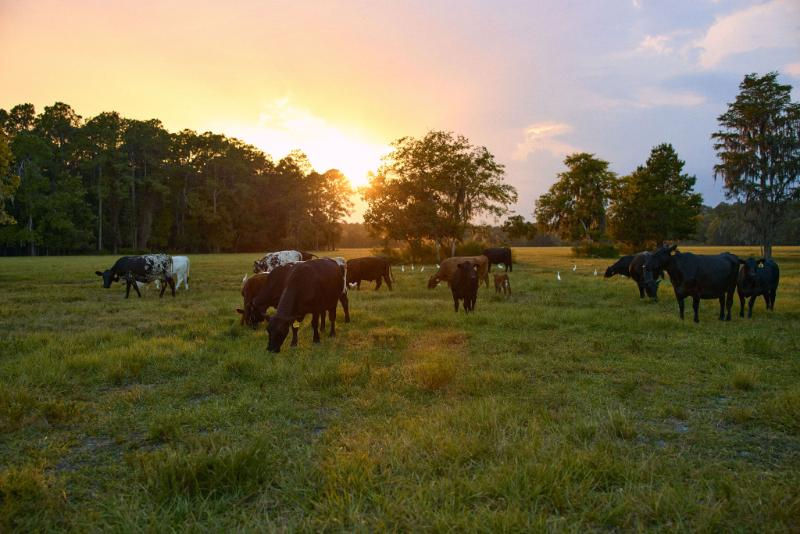What It Means to Eat Local
- Lauren Titus

- Sep 17
- 7 min read
A Ten Year Retrospective

When Edible Northeast Florida published its first issue in September 2015, the goal was to celebrate the story of local food. Ten years later, that remains our mission. We still love going behind the scenes and talking about food that is locally grown, marketed and consumed in our region. And it seems that there still exists an appetite for supporting local food systems, based on the network of farmers’ markets throughout the region, the robust proliferation of small, entrepreneurial food-related enterprises and a community more engaged and connected than ever before around the table.
Yet the question remains: what, exactly, does “local” mean? As was the case ten years ago, there is no universal definition of what “local” food means. According to the National Agricultural Law Center, “local food is food that travels the entire supply chain (from production to consumption) in the same locality. What is considered local is highly dependent on geography.” Because there is no federally established definition, the meaning of “local food” can vary substantially between state and local governments, nonprofit organizations and the private sector.
A clause in the 2008 Food and Farm Act stipulates that products that travel less than 400 miles from their original point of origin, or products produced within the same state, can be labeled “locally or regionally produced.” When consumers read “local” on labels, social media or even billboards, there’s no way of knowing how the “localness” of that product or service is defined. For some consumers, local refers specifically to food grown within a particular region, generally close to home. For others, local food is associated with specialty products marketed by grocers, restaurants or artisan food makers. And for others, there is a social component; buying local means knowing and supporting the people and businesses that have had a hand in bringing one's food to the table.
Frankly, it seems like the answer to the question is all of the above. Our definition must include producers of all kinds, including individuals and institutions engaged in processing, distributing and selling food within Northeast Florida. If we take a narrow view of what it means to eat local, we may end up losing sight of the value to our health, our communities and our economy. Here’s where we’ve landed after ten years of stories about local food.
LOCAL IS A FOOD SYSTEM
When Henry Flagler considered how he would feed guests at his famous Ponce de León Hotel in St. Augustine, he collaborated with Thomas Hastings to establish a nearby farming community to supply his ventures. What started as a small, diversified farming district in the late 1800s is now known as Hastings, recognized for its large-scale production of potatoes, cabbage and other produce. Flagler regarded food not in terms of individual products or services but as an entire food system—a network of mutually beneficial relationships that support one another in growing a regional economy. Not only would excessive transportation and long-term storage diminish the quality of products served to guests, but sourcing at a distance also passed over opportunities to create local jobs and cultivate a new market of consumers willing and able to buy their own region’s products. In short, buying too much produce from afar didn’t make good business sense. And some make that same argument today.
Is it possible to eat 100% local all the time? This depends on one’s culinary creativity and diligence in sourcing. To be able to eat locally, one needs to know what’s available each season. In Northeast Florida, we’re able to grow a wide diversity of produce in the winter months. During the hot and buggy days of summer, not so much. But that doesn’t mean that a shift in the direction of “local” isn’t both doable and desirable.
LOCAL IS KNOWING YOUR FOOD
Over the past ten years we’ve seen an increase in urban and micro agriculture, as a new generation of food makers recognize the need for a systemic, sustainable approach to the cultivation and production of food. The good news for these growers and producers is that consumer trends are shifting and awareness is on the rise. Indeed, supply chain disruptions during the recent pandemic may have helped accelerate demand for locally grown food that is traceable to its source, humane and sustainable in its production. These new farmers and “real food” advocates are responding to consumer trends while also battling the market realities of providing such products (often at slightly higher prices or in locations that aren’t as convenient for shoppers).
As Leslie Kaplan, chapter leader of Slow Food First Coast notes, “Having taught a college class on food and culture for the last 20 years, I've noticed increasing interest from students in learning about where their food comes from. Increasingly, young people are looking for food that is “clean” meaning that it is minimally processed. Local food businesses offer more transparency about how food is processed. Slow Food First Coast offers the community a yearly Tour de Farm introducing the public to local farmers, and we see great interest from the community in these events.”
LOCAL IS BIG-PICTURE THINKING
The irony of eating local, of course, is that it requires big-picture thinking. Home cooking and backyard gardening experienced a surge of enthusiasts out of necessity during the pandemic. Once life resumed its routine pace, though, how many of us had time to grow and cook all our food or make sourdough bread on a weekly basis? Charming and quaint as it might sound, small farming in Northeast Florida is not easy, nor is running a small food business committed to sourcing locally. Business challenges, like pricing products competitively and reducing spoilage rates when food does not sell, educating consumers on the value of your products or finding time to market and distribute your goods, are real. Still, the number of local farms and producers with big-picture thinking is growing, and with that growth, more food system efficiencies will come.
Yet even with this increase in small farms there remains a gap between what local growers can provide and the volume required by eateries that wish to source as much local products as possible. “Although we’ve had some farm partners for 15 years, the ability of purveyors to get us what we need doesn’t keep up with demand,” says Genie McNally, chef and co-owner, along with her husband Jeff, of The Floridian and Bea’s Fine Food in St. Augustine. “Yes, our priority is to support local. But as a business that uses locally sourced food, for it to be sustainable not only to the supplier but to our employees who process the ingredients and make food from scratch, your costs are higher.”
So, has farm-to-table and restaurant-farmer connections become just a buzzword, something that is of interest when it is convenient? Consumer economics drives dining decisions, which means support for local food may ebb and flow or not be consistent. “We try to keep sourcing information on the menu, but there has been less interest since we opened. Still, sourcing locally is important to us. Support at any level is a good thing, even if now it may have become a trend or a small percentage of a restaurant’s sourcing,” says Jeff McNally. “It’s better than zero percent. Getting people to think about where their food comes from is a good thing.”
Over the past ten years, Chef Tom Gray has added two concepts, Town Hall and Electric Dough Pizza Co., to his restaurant group that also includes Prati Italia. Over that time period, he has seen fewer farms and options to source locally at the volume he needs for the three restaurants. “What hasn’t changed is the amount of work and effort it takes to find local suppliers,” Gray says. “Bacon Farms is a major supplier in season, but during the summer they take a much-needed break. Right now, I need an herb supplier, because everyone started growing microgreens.”
Gray has also seen consumer interest in local sourcing fluctuate, but for him, “It’s more than a buzzword. It’s a starting point. From there, we’re making decisions that align with what’s important to us as a business and personally.” As he has seen the evolution of what’s available and how to get it, he has shifted to expanding his reach for local suppliers and also taking a hyperlocal approach. “We look at what we can do ourselves, what we can get locally and what products are better-for-you that I can source,” says Gray. “For instance, we make more from scratch, like pasta, long fermented pizza dough and ricotta cheese for all three restaurants.”
LOCAL IS FARMERS' MARKETS
It’s impossible to understand the value of eating local without paying homage to the role that farmers' markets play in supporting our local food system. Markets provide an iconic opportunity for consumers to gather and engage with the people who grow and make their food. They are a place of commerce but also a place of community, a conduit for connection. Over the past ten years we have seen several new markets launch in various neighborhoods like Palm Valley, Nocatee and Atlantic Beach. While not every farmers’ market will exclusively feature vendors who source produce from local farms, many are helping define “local” by establishing clear guidelines and parameters for vendor participation.
LOCAL IS COMMUNITY
How do these conversations shape our understanding of what it means to “eat local”? That's a story still unfolding. We know it's about more than mileage designations or boundaries on a map. We know it's about more than food. Until we have the answers, we keep asking questions -- about where our food is from, how it landed on our plates and whether or not it's good for people and the planet. Perhaps the spirit of eating local is, at its core, about supporting our community in creating a more resilient, sustainable food system for everyone around the table.




























Comments